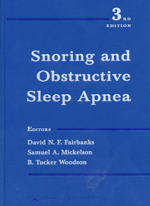1.Snoring: A General Overview with Historical Perspectives
2. Pathophysiology of Snoring and Obstructive Sleep Apnea:
Airway Dynamics
3. Cardiovascular, Pulmonary, and Neurological Consequences of
Sleep-Disordered Breathing
4. Obstructive Sleep Apnea: Evaluation by History and
Polysomnography
5. Obstructive Sleep Apnea: Evaluation by Physical Examination
and Special Studies
6. Disorders of Excessive Sleepiness: Differential Diagnosis
7. Drugs, Devices, and Oral Appliances for Snoring and
Obstructive Sleep Apnea
8. Positive Airway Pressure for Obstructive Sleep Apnea
9. Uvulopalatopharyngoplasty (UPPP)
9.1 UPPP: Techniques, Pitfalls, and Risk Management
9.2 Clinical Staging
10. Upper Pharyngeal Airway Surgery
10.1 How Much Palate to Resect
10.2 Cold Surgical Instrument Uvulectomy and Uvuvlopalatoplasty
10.3 Electrocautery for Uvulopalatoplasty
10.4 Cautery-Assisted Palatal Stiffening Operation
10.5 The Uvulopalatal Flap
10.6 Laser-Assisted Uvulopalatoplasty
10.7 Radiofrequency Ablation
10.8 Injection Snoreplasty
10.9 Transpalatal Advancement Pharyngoplasty
11 Lower Pharyngeal Airway Surgery
11.1 Radiofrequency Tissue Volume Reduction of the Tongue
11.2 Genioglossus Advancement
11.3 Hyoid Suspension/Advancement
11.4 Maxillomandibular Advancement
11.5 Transoral Midline Glossectomy and Lingualplasty
11.6 Tongue Base Reduction with Hyoepiglottoplasty for Severe
Obstructive Sleep Apnea
12 The Nose and its impact on Snoring and Obstructive Sleep Apnea
13 Tracheostomy for Obstructive Sleep Apnea
14 Perioperative and Anesthesia Management in Obstructive Sleep
Apnea Surgery
15 Obesity Management for Obstructive Sleep Apnea
16 Snoring and Obstructive Sleep Apnea in Children
17 Patient Selection and Treatment Decisions


